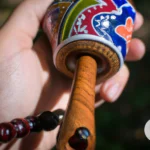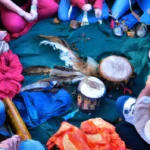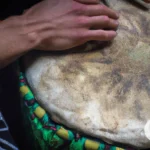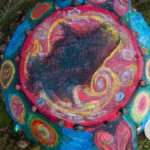Have you ever found yourself lost in the beat of a powerful drum, swept away by the sounds of flutes and rattles, transported to a world beyond the physical? If so, you may have experienced the trance-inducing power of shamanic music. Shamanism is an ancient practice found in cultures all across the globe, and its use of music to connect with the spirit world has been a vital part of shamanic healing traditions worldwide. In this in-depth exploration into the history and significance of shamanic trance music, we’ll delve into the roots of this powerful practice, the ways in which it can be used to induce altered states of consciousness, and how you can create your own shamanic trance music for personal use. So sit back, relax, and let the beat take you on a journey.
The Roots of Shamanic Trance Music
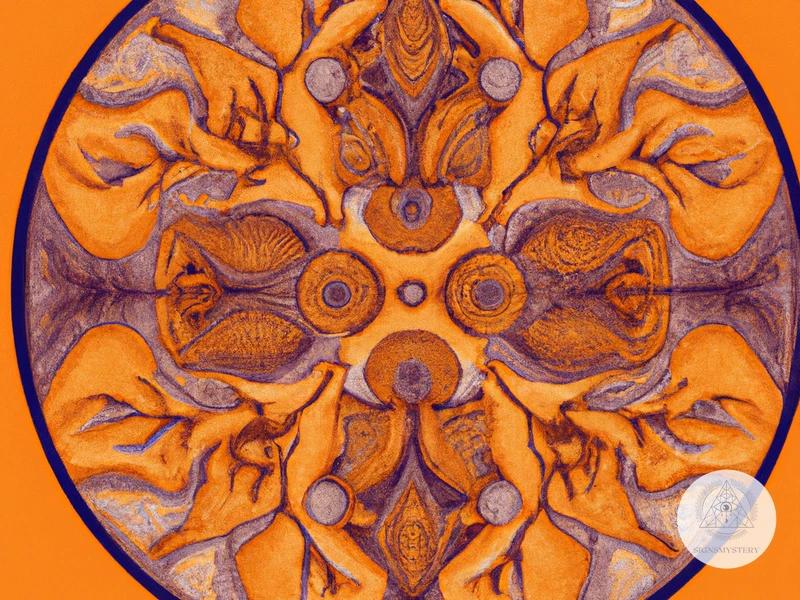
Shamanic Trance Music has its roots deeply embedded in the practices of ancient cultures and traditions. Shamanic Music Across Cultures and Regions has its own unique style and instruments, but they all share a common goal of inducing a trance-like state in the shaman and the participants. Various regions utilized different instruments such as the didgeridoo in Australia, the frame drum in the Middle East and Siberia, and the rattle and flute in North America. The Role of Music in Shamanic Healing Practices played a significant part in shamanic rituals as it was believed that music had the power to shift and alter states of consciousness thereby enabling the shaman to connect with the spirit world. The use of music also helped in treating ailments such as depression and anxiety through entrainment of brainwaves. The roots of Shamanic Trance Music run deep and hold a significant place in the spiritual and healing practices of several cultures around the world.
Shamanic Music Across Cultures and Regions
The roots of shamanic music can be traced back to the early days of human history. Shamanic music is not unique to a single culture or region, but rather is a practice that has emerged independently in several regions of the world. It is an integral part of shamanic traditions across the globe, from the indigenous peoples of North and South America to the shamans of Siberia.
In Siberian shamanism, the music is predominantly based on drumming. The shaman often uses a drum made from a hollowed-out tree trunk and covered with reindeer skin. The drum acts as a tool to connect with the spirits and connect with the physical world. In South America, shamanic music is often accompanied by the sounds of the icaros – songs that are believed to be sung by the plant spirits themselves. The icaros guide the shaman’s journey and unlock the power of healing.
Australian aboriginal music includes the use of the didgeridoo – a long wooden pipe instrument that produces a low, primal drone. The didgeridoo is believed to connect the living with the ancestors and the spirit world. In North America, the shamanic music is characterized by chanting and the use of rattles and flutes. These instruments symbolize the transformative power of the natural world and connect shamans to the spirits and deities that govern our world.
Despite their differences, shamanic music across cultures and regions shares universal themes and motifs. The use of music in shamanic traditions is believed to allow the shaman to enter into altered states of consciousness, connect with the spirits, and invoke healing energy. Through music, shamans can create a bridge between the physical world and the spiritual world, accessing knowledge, and wisdom from beyond our daily experience.
If you are interested in learning more about shamanic music across cultures and regions, check out some of the articles from our website. For example, you can learn more about shamanic instruments and how they are used in different traditions. You can also read about the different styles of shamanic trance music that have emerged over the years. Additionally, you can explore the role of chanting in shamanic music and how it can induce altered states of consciousness. Whatever your interest, there is much to discover about the diverse and fascinating world of shamanic music.
The Role of Music in Shamanic Healing Practices
can’t be overstated. Music is an essential component of shamanic healing practices in various cultures across the world.
In many indigenous cultures, the shaman, a figure who acts as both a healer and spiritual leader, uses music to enter into trance states and communicate with the spirit realm. The music serves as a medium for the shaman to connect with the spirit world and access other states of consciousness. The shaman understands that music has a transformative power, and can alter our states of being.
The shamanic drum is one of the most crucial instruments in shamanic healing practices. The sound of the drum creates a steady and rhythmic heartbeat, a fundamental aspect of shamanic music. With the sound of the drum, the shaman can induce a trance-like state in themselves and others, which allows access to the subconscious and spiritual realms.
The role of music in shamanic healing extends beyond inducing trance states. It also serves as a tool for healing, releasing trauma, and restoring balance to one’s being. The rhythms and sounds of shamanic music can help to align a person’s energy and bring them into a state of harmony and wholeness.
Shamanic music is effective for treating a variety of physical and mental ailments, including anxiety, depression, and chronic pain. The therapeutic benefits of shamanic music are well documented, with numerous studies showing its positive effects on both physical and mental health.
In modern times, we have access to various tools and resources that allow us to create our own shamanic music playlists. There are also many workshops and courses that teach people how to create shamanic music and incorporate it into their healing practices.
Whether you are a shaman or simply someone interested in exploring the healing power of music, shamanic trance music is a valuable tool for accessing altered states of consciousness, promoting healing, and restoring balance to your being.
The Power of Shamanic Trance Music
Shamanic trance music has a profound power to induce altered states of consciousness and facilitate spiritual experiences. The repetitive beats and sounds of shamanic music provoke a state of ‘mind awake, body asleep,’ which allows you to connect with your inner self and the spirit realm. During a trance state, you can gain access to higher realms of wisdom, receive messages from your spirit guides, and experience deep healing. Shamanic trance music has been used for centuries in different cultures around the world and is still relevant today for improving mental and emotional well-being. If you want to experience the therapeutic benefits of shamanic trance music, consider creating your own playlist or exploring different styles and techniques.
How Music Induces Shamanic Trance States
Shamanic trance music is specifically designed to induce altered states of consciousness, allowing seekers to connect with their inner selves and with the spiritual world. The way shamanic trance music works is by influencing brainwave activity, ultimately leading to a state of trance. Music can trigger the release of endorphins, which help to relax the mind and body. Additionally, it can also stimulate the production of serotonin, a hormone that regulates mood and memory.
The repetitive rhythms and beats found in shamanic trance music play a crucial role in inducing trance-like states, as they help to slow down brainwave activity, leading to a relaxed mental state. Shamanic music builds on the use of repetitive beats and drumming patterns that mirror the rhythmic flow of the natural world. This repetition creates a hypnotic effect that allows for deeper listening, making it easier to enter a state of trance.
Certain sound frequencies are associated with specific states of consciousness, such as the theta and delta frequencies, which are often associated with deep meditation and sleep. These frequencies can be found in shamanic trance music and are used to help induce a trance state. For example, the steady drumbeat found in shamanic music can lead to the release of theta brainwaves, which are typically associated with deep relaxation and meditation.
The use of binaural beats, where two different tones are played in each ear to create a subtle rhythmic difference, also contributes to the effectiveness of shamanic trance music in inducing trance states. These beats help to synchronize the two hemispheres of the brain, leading to a sense of calmness and relaxation that can aid in the journey towards altered states of consciousness.
Shamanic trance music has a significant impact on inducing altered states of consciousness. By influencing brainwave activity with the use of repetitive rhythms, specific sound frequencies, and binaural beats, shamanic trance music allows individuals to enter a state of trance easily. If you’re interested in exploring shamanic music, you can check out our guide on how to create a shamanic trance playlist or learn more about the therapeutic benefits of shamanic trance music and the power of music in altering states of consciousness.
Benefits of Shamanic Trance Music for Overall Well-Being
Shamanic trance music has been known to provide numerous benefits to the mind and body, especially when it comes to overall well-being. First and foremost, this type of music helps to induce deep relaxation and alleviate stress. The tribal beats and rhythms help to slow down the heart rate and breathing, thereby giving a sense of calm.
Apart from stress relief, shamanic trance music also has the power to boost one’s mood and energy levels. It stimulates the release of endorphins in the brain, which are responsible for creating feelings of pleasure, euphoria and happiness. Additionally, it can improve focus and mental clarity, which can be helpful in achieving better cognitive functioning.
Some people have reported experiencing profound spiritual experiences and gaining a deeper connection with themselves and the world around them through shamanic trance music. It is believed that the music has the ability to open up different parts of the brain and access a higher state of consciousness, which can lead to greater self-awareness and insight.
Shamanic trance music has been known to have a positive impact on physical health. The deeply relaxing nature of the music can help to lower blood pressure, decrease the levels of stress hormones in the body, and boost the immune system. It can also provide relief from pain and discomfort by promoting the release of natural painkillers in the body.
The benefits of shamanic trance music for overall well-being cannot be overstated. It has the power to promote deep relaxation, boost mood and energy levels, improve focus and mental clarity, provide spiritual experiences, and positively impact physical health. Incorporating this type of music into one’s daily routine can be a simple yet effective way to enhance one’s quality of life.
Shamanic Drumming: The Heartbeat of Trance Music
Central to the experience of shamanic trance music is the shamanic drumming, which is also often referred to as the “heartbeat of trance music”. The sound of the drum is believed to be the voice of the shaman’s helping spirits and serves to bridge the gap between the physical and spiritual worlds.
Shamanic drumming involves using a drum, typically made from animal hide stretched over a frame, and a drumstick or beater. The drumming is usually repetitive, with a consistent tempo that mimics the natural rhythm of the heart. This rhythmic pattern provides a focus for the shaman and the participants in the ceremony, helping to induce a trance-like state.
During shamanic drumming, the shaman or drumming leader will often lead the group with a specific beat or rhythm, allowing the participants to align their energy and enter into a deeper trance state. As the drumming continues, the energy of the group builds and intensifies, creating an atmosphere of heightened spiritual awareness.
It’s believed that the shamanic drumming has physical and psychological effects on the body and mind. Studies have shown that repetitive drumming can induce a theta brainwave state, which is associated with deep relaxation and meditation. It also triggers the release of endorphins, which can elicit feelings of euphoria and well-being.
In shamanic cultures, the drum is considered a sacred instrument, and the act of drumming is seen as a way to connect with the spirit world and the natural elements. It’s believed that the rhythm of the drum can evoke images of specific animals or landscapes, providing a powerful tool for spiritual journeying and vision quests.
Shamanic drumming is an essential component of shamanic trance music. As the “heartbeat” of the ceremony, it provides a potent and transformative force that helps participants enter into a deep and profound state of spiritual awareness.
Shamanic Trance Music in Modern Times

Shamanic Trance Music has been adapted to contemporary contexts and needs to cater to modern listeners. The use of technology has widened the scope of the genre and allows for the fusion of different sounds and styles. The integration of tradition and innovation has created unique listening experiences for individuals. With the rise of global audiences and festivals, Shamanic Trance Music has gained popularity and recognition. It has also paved the way for musicians to explore and experiment with different techniques and styles. The genre has influenced other music forms, such as ambient and electronic music. The use of repetitive rhythms and beats in Shamanic Trance Music induce altered states of consciousness, leading to improved overall well-being and spiritual growth. To fully experience the transformative power of Shamanic Trance Music, creating a ritual space for music is important. The experience is enhanced when listeners surrender their minds to the rhythm and beat of the music, allowing them to journey through their consciousness and encounter deeply profound transformations.
Adapting to Contemporary Contexts and Needs
As the world continues to evolve, so does the way we create and consume music. Shamanic trance music has not been immune to this trend, and many contemporary artists have adapted the genre to meet the needs and expectations of modern audiences.
One way in which shamanic trance music has adapted is through the integration of modern technology. While traditional shamanic music was often performed solely with acoustic instruments, contemporary artists have incorporated electronic elements such as synthesizers and drum machines to create a more dynamic sound.
Another adaptation has been the incorporation of musical styles from around the world. This has led to the emergence of new sub-genres such as psychedelic trance and ambient music, which blend traditional shamanic rhythms with contemporary electronic elements.
In addition, contemporary shamanic trance music has been used in a variety of contexts beyond traditional healing practices. It can be found in yoga classes, meditation sessions, and even in nightclubs.
However, some critics argue that the commercialization of shamanic music has led to
Subscribe to Our Newsletter
Sign up to receive the latest news and updates.
Despite these concerns, many artists continue to create innovative and boundary-pushing shamanic trance music that adapts to the contemporary world while still respecting its historical roots. By embracing this evolution, shamanic trance music can continue to thrive and resonate with a new generation of listeners.
Integrating Technology and Tradition in Trance Music
Integrating Technology and Tradition in Trance Music has become a prevalent aspect of modern shamanic practices. Technology has given new dimensions to traditional music, enabling its adaptation to contemporary audiences. The fusion of traditional instruments with modern electronic sounds has created a unique and euphonic sound that has contributed to the increasing popularity of shamanic trance music.
One way technology has been integrated with tradition is through sound sampling. Contemporary shamanic musicians sample traditional music and infuse it with modern sounds and rhythms, creating a new genre of music that retains the essence of traditional shamanic music. The fusion of traditional sounds with electronic and synthesized sounds, transforms trance music into a more versatile and appealing form of music.
Another way in which technology has helped in integrating tradition and modernity is through the use of music software. Shamanic musicians use digital audio workstations (DAW) such as Ableton Live, Cubase, and Logic Pro, to create music with a combination of traditional and modern instruments. The use of these software programs has expanded the possibilities of shamanic trance music, enabling a wider range of sounds, effects, and rhythms.
The emergence of digital distribution platforms like YouTube, SoundCloud, and Spotify has enabled shamanic trance music to reach a wider audience. The integration of technology has helped shamanic musicians to market and distribute their music globally and expand their impact. It has also provided an opportunity for artists to connect and collaborate with other musicians from different parts of the world.
The integration of technology with tradition has enhanced shamanic trance music, making it more relevant and appealing to modern audiences. The use of new tools has enabled musicians to expand their creativity and innovate, resulting in a sound that is both traditional and contemporary. The fusion of traditional and modern sounds has taken shamanic trance music to new heights, contributing to its growing popularity around the world.
Making Your Own Shamanic Trance Music: A Guide
Crafting your own shamanic trance music can be a deeply meditative and spiritual experience. To start, consider selecting instruments that resonate with your intention and personal preferences. Some common instruments used in shamanic music include drums, rattles, flutes, bells, and chimes. Creating a designated space for your music-making ritual can also enhance the experience, whether it be in nature or within the comfort of your own home. Experiment with different techniques and styles, allowing yourself to become immersed in the rhythms and vibrations of the music. Remember to approach the process with an open mind and heart, allowing the music to guide you on a transformative journey.
Choosing the Right Instruments and Sounds
When it comes to creating shamanic trance music, choosing the right instruments and sounds is crucial. In fact, the traditional shamanic music is mainly characterized by the use of specific instruments that have been used for centuries in shamanic rituals. These instruments include drums, rattles, flutes, didgeridoos, and singing bowls.
Drums are perhaps the most essential instrument when it comes to shamanic trance music. The traditional shamanic drum is usually made from a single piece of wood and is around 14-18 inches in diameter. The drum is often decorated with spiritual symbols and motifs, and the drumhead is made from animal hide, usually deer or buffalo. The rhythm of the drumbeat is very important, and specific beats are often associated with certain spirits or energies.
Rattles are another important instrument in shamanic music. They can be made from various materials such as gourds, seeds, or shells. Rattles create a high-pitched sound that complements the deeper sound of the drum. The rhythm of the rattle can also be varied to create different effects and energies.
Flutes and didgeridoos are often used to create a melody or a drone that complements the rhythm of the drum and the rattle. The melodic nature of these instruments can help to take the listener deeper into a trance state. Singing bowls, on the other hand, are used for their healing properties. They produce a soothing sound that can help to balance the energy centers of the body.
When choosing the right instruments and sounds for your shamanic trance music, it is important to consider the purpose and intention of your music. Each instrument and sound has a unique energy and vibration that can support different types of trance experience. Experimenting with different combinations of instruments and sounds can help you to find what works best for you and your listening audience.
Creating a Ritual Space for Trance Music
Creating a Ritual Space for Trance Music is a critical aspect of the shamanic practice that enables the participants to experience a deeper level of connection and transformative power. Here are some essential steps to consider when creating a ritual space for your shamanic trance music experience:
| Step | Description |
|---|---|
| Step 1: | Choose a location that is comfortable, quiet, and private, where you can spend some time alone or with a small group of trusted people. |
| Step 2: | Create an altar that reflects your intentions and goals for the shamanic journey, and include items that have symbolic value to you, such as crystals, feathers, candles, or pictures. |
| Step 3: | Set the mood by using incense, smudging herbs, essential oils, or other fragrances that can help you relax and focus your mind. |
| Step 4: | Use lighting to create a soothing atmosphere and reduce distractions. Consider using dimmer switches or candles to adjust the brightness and create a sense of intimacy. |
| Step 5: | Choose appropriate clothing that is comfortable and reflects the spirit of the ritual. Avoid wearing anything that is too tight, too hot, or too revealing, as it can distract you from your experience. |
| Step 6: | Prepare yourself mentally and emotionally by setting your intentions, meditating, or doing other grounding practices that help you clear your mind and focus on your purpose. |
| Step 7: | Invite trusted friends or allies who can provide support and guidance during the shamanic journey, and create a safe and respectful container for your experience. |
By following these steps, you can create a transformative ritual space for your shamanic trance music experience that allows you to let go of your everyday concerns and immerse yourself in the healing power of sound and rhythm. Remember, the most critical factor in creating a ritual space is your intention and commitment to the experience. With an open mind and heart, you can create a sacred space that guides you into the depths of your soul and beyond.
Experimenting with Different Techniques and Styles
To truly create shamanic trance music, experimentation with different techniques and styles is essential. One of the most popular techniques is incorporating a steady, repetitive rhythm using shamanic drums or other percussive instruments. Additionally, adding nature sounds like rain, wind, or thunder can enhance the experience and transport the listener even deeper into a trance state.
Another technique is utilizing call and response, where a lead instrument or voice plays a melody or chant, and other instruments or voices respond in unison. This can create a sense of community and connection with the music and other listeners.
In terms of styles, shamanic trance music can vary widely depending on regions and cultures. For example, the indigenous people of South America use icaros, which are ceremonial songs used during shamanic ceremonies to connect with the spirits of the Amazon rainforest.
Meanwhile, the Samis of northern Europe use yoik, a style of singing that mimics the sounds of nature and animals. Similarly, the Aboriginal people of Australia use didgeridoos to imitate the sounds of their environment and connect with their ancestors.
In modern times, shamanic trance music has also incorporated electronic and ambient music styles, such as psybient and psytrance, which can create an otherworldly atmosphere.
Ultimately, experimenting with different techniques and styles allows for a unique and personal expression of shamanic trance music. It is a fluid and evolving form of music that draws from ancient traditions and continues to adapt and inspire new generations of listeners.
Conclusion
In conclusion, shamanic trance music has a long and rich history, spanning across different cultures and regions. Its significance lies in its ability to induce altered states of consciousness and promote healing and overall well-being. The use of shamanic drumming and other instruments creates a powerful and immersive experience for both the shaman and the audience.
While shamanic trance music may hold traditional roots, it has also adapted to contemporary contexts and needs. The integration of technology and tradition has opened up new possibilities for creating and experiencing shamanic music.
For those interested in making their own shamanic trance music, it is important to choose the right instruments and sounds and create a ritual space that promotes a meditative atmosphere. Experimenting with different techniques and styles can lead to a unique and personal expression of shamanic trance music.
Overall, shamanic trance music offers a powerful means of connecting with ourselves, our environment, and the larger universe. Its continued practice and exploration can lead to a deeper understanding of our place in the world and our relationship with the spiritual realm.
Key Takeaways
- Shamanic trance music has a long and rich history across different cultures and regions.
- The power of shamanic trance music lies in its ability to induce altered states of consciousness and promote healing and overall well-being.
- Shamanic drumming and other instruments create a powerful and immersive experience for both the shaman and the audience.
- Shamanic trance music has adapted to contemporary contexts and needs, integrating technology and tradition.
- Creating personal shamanic trance music involves choosing the right instruments and sounds, creating a ritual space, and experimenting with techniques and styles.
Frequently Asked Questions
What is shamanic trance music?
Shamanic trance music is a form of music used in shamanic practices to induce altered states of consciousness and facilitate healing and spiritual connection.
Where did shamanic trance music originate?
Shamanic trance music has been used by various indigenous cultures throughout the world, including Native American, African, and South American tribes.
What instruments are commonly used in shamanic trance music?
The most common instruments used in shamanic trance music include drums, rattles, flutes, and chanting.
How does shamanic trance music induce altered states of consciousness?
Shamanic trance music typically follows a repetitive rhythm and pattern, which can help to entrain the brain and induce a trance-like state.
What are the benefits of shamanic trance music for overall well-being?
Shamanic trance music has been shown to reduce stress, anxiety, and depression, improve mood and cognitive function, and enhance feelings of spiritual connection and well-being.
What is shamanic drumming?
Shamanic drumming is a type of rhythmic drumming that is often used in shamanic trance music and is thought to simulate the heartbeat of the earth.
How can modern technology be integrated into shamanic trance music?
Modern technology such as electronic music production software and MIDI controllers can be used to create unique sounds and loops in shamanic trance music.
What is the process for making your own shamanic trance music?
The process for making your own shamanic trance music involves selecting appropriate instruments and sounds, creating a ritual space, and experimenting with different techniques and styles.
Is it possible to achieve shamanic trance states without music?
While shamanic trance music can be a powerful tool for inducing altered states of consciousness, it is possible to achieve these states through other means such as meditation, breathwork, or sensory deprivation.
Can shamanic trance music be used in conjunction with other forms of therapy?
Shamanic trance music can complement other forms of therapy such as psychotherapy, hypnotherapy, and mindfulness-based practices, and may enhance their effectiveness.





